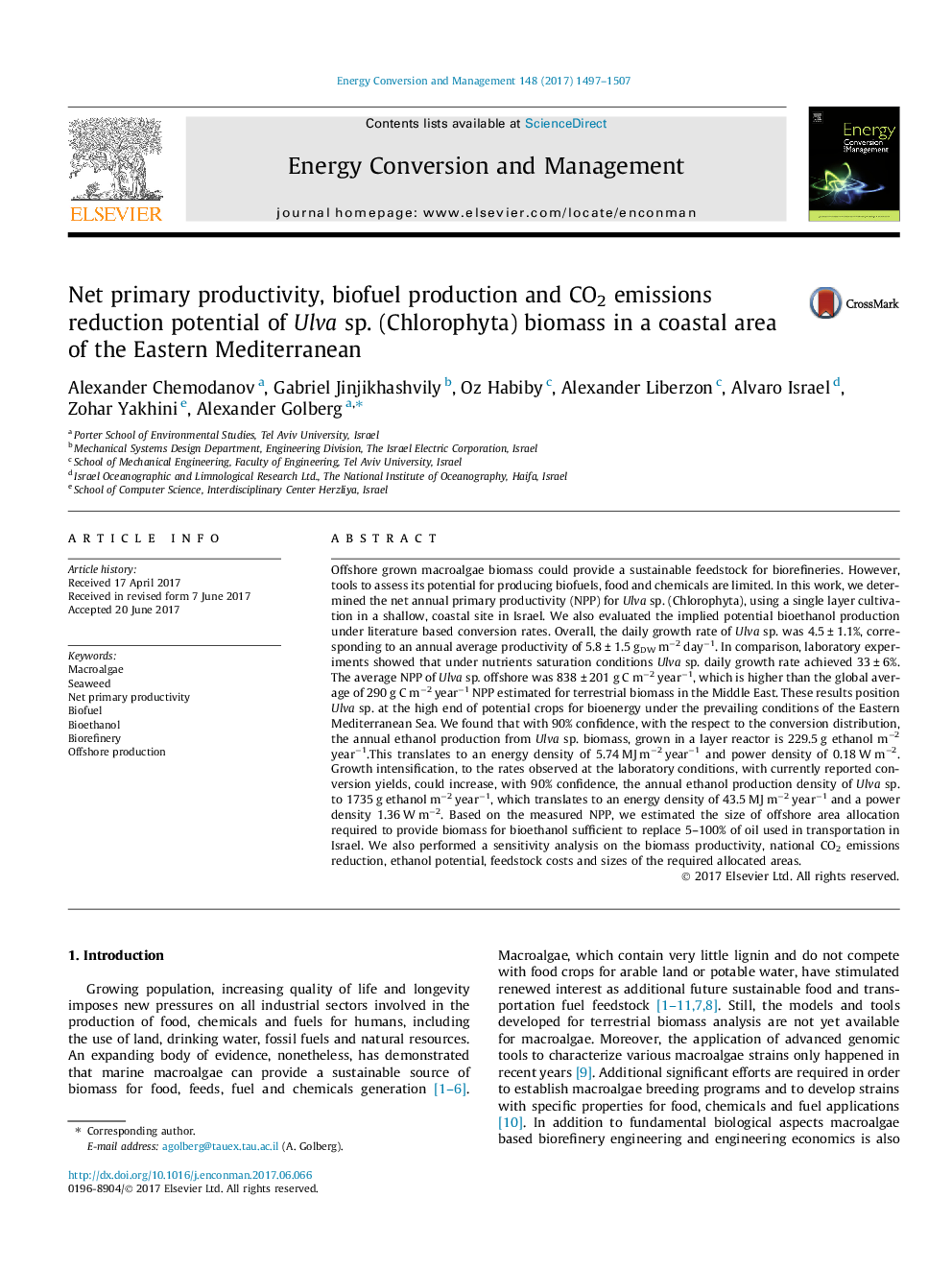| کد مقاله | کد نشریه | سال انتشار | مقاله انگلیسی | نسخه تمام متن |
|---|---|---|---|---|
| 5012598 | 1462814 | 2017 | 11 صفحه PDF | دانلود رایگان |
عنوان انگلیسی مقاله ISI
Net primary productivity, biofuel production and CO2 emissions reduction potential of Ulva sp. (Chlorophyta) biomass in a coastal area of the Eastern Mediterranean
دانلود مقاله + سفارش ترجمه
دانلود مقاله ISI انگلیسی
رایگان برای ایرانیان
کلمات کلیدی
موضوعات مرتبط
مهندسی و علوم پایه
مهندسی انرژی
انرژی (عمومی)
پیش نمایش صفحه اول مقاله

چکیده انگلیسی
Offshore grown macroalgae biomass could provide a sustainable feedstock for biorefineries. However, tools to assess its potential for producing biofuels, food and chemicals are limited. In this work, we determined the net annual primary productivity (NPP) for Ulva sp. (Chlorophyta), using a single layer cultivation in a shallow, coastal site in Israel. We also evaluated the implied potential bioethanol production under literature based conversion rates. Overall, the daily growth rate of Ulva sp. was 4.5 ± 1.1%, corresponding to an annual average productivity of 5.8 ± 1.5 gDW mâ2 dayâ1. In comparison, laboratory experiments showed that under nutrients saturation conditions Ulva sp. daily growth rate achieved 33 ± 6%. The average NPP of Ulva sp. offshore was 838 ± 201 g C mâ2 yearâ1, which is higher than the global average of 290 g C mâ2 yearâ1 NPP estimated for terrestrial biomass in the Middle East. These results position Ulva sp. at the high end of potential crops for bioenergy under the prevailing conditions of the Eastern Mediterranean Sea. We found that with 90% confidence, with the respect to the conversion distribution, the annual ethanol production from Ulva sp. biomass, grown in a layer reactor is 229.5 g ethanol mâ2 yearâ1.This translates to an energy density of 5.74 MJ mâ2 yearâ1 and power density of 0.18 W mâ2. Growth intensification, to the rates observed at the laboratory conditions, with currently reported conversion yields, could increase, with 90% confidence, the annual ethanol production density of Ulva sp. to 1735 g ethanol mâ2 yearâ1, which translates to an energy density of 43.5 MJ mâ2 yearâ1 and a power density 1.36 W mâ2. Based on the measured NPP, we estimated the size of offshore area allocation required to provide biomass for bioethanol sufficient to replace 5-100% of oil used in transportation in Israel. We also performed a sensitivity analysis on the biomass productivity, national CO2 emissions reduction, ethanol potential, feedstock costs and sizes of the required allocated areas.
ناشر
Database: Elsevier - ScienceDirect (ساینس دایرکت)
Journal: Energy Conversion and Management - Volume 148, 15 September 2017, Pages 1497-1507
Journal: Energy Conversion and Management - Volume 148, 15 September 2017, Pages 1497-1507
نویسندگان
Alexander Chemodanov, Gabriel Jinjikhashvily, Oz Habiby, Alexander Liberzon, Alvaro Israel, Zohar Yakhini, Alexander Golberg,